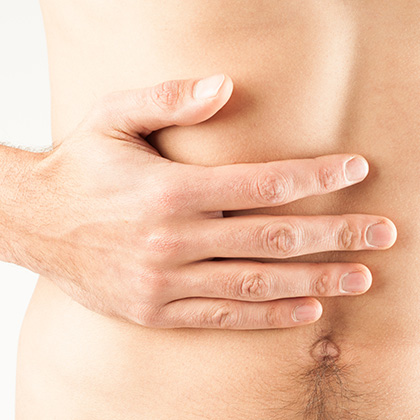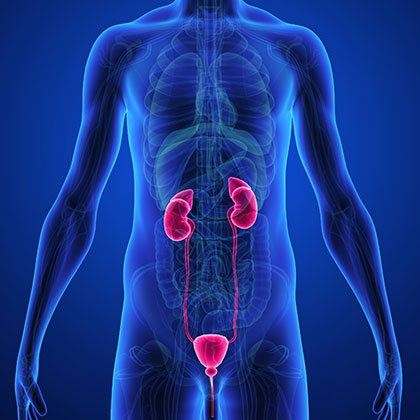
There are several names for live bacteria. You may hear them referred to as probiotics, live cultures, ‘good’ or ‘friendly’ bacteria, gut bacteria, gut flora or microflora, or even as the gut microbiome or microbiota. Whatever you call them, they’re the same thing – the beneficial bacteria that live in the human digestive tract.
Although the word ‘bacteria’ is often associated with harmful infections, these live bacteria are actually benefical to human health, that’s why they’re often described as good, friendly and beneficial.
It’s estimated there are more than a trillion bacteria made up of more than 500 different species living in your digestive system (i) alongside other micro-organisms such as fungi, archea, helminths and viruses. According to the British Dietetic Association, the number of bacteria in the human gut is almost 10 times more than the number of human cells in the body (ii). And if you could put all your gut bacteria together, they would weigh about 1kg.
Thankfully the vast majority of these bacteria are either beneficial or harmless – around 90 per cent or thereabouts if you’re healthy. The remaining 10 per cent are thought of as less than beneficial or even potentially harmful. So, keeping the balance tipped widely in favour of ‘good’ rather than ‘bad’ is important for your health. Health experts have been researching live bacteria for many years, but only now are they realising how important it is to have a healthy gut bacteria balance for our overall wellbeing.
Why are live bacteria essential?
One of the main jobs performed by the live friendly bacteria in your gut is to prevent the growth of harmful bacteria and other micro-organisms, which may help prevent ill health. However, your gut microbiota also play an important role in many other body functions, some of which include:
-
Nutrient production (your gut bacteria manufacture vitamins and other nutrients including several B vitamins, vitamin K, folate and short-chain fatty acids)
-
Energy production (up to 10 per cent of your daily energy requirements can be met by the byproducts of bacterial fermentation in the gut)
-
Normal immune system development
-
Gut barrier reinforcement
-
Bile salt metabolism
-
Enzyme activity
-
Toxin neutralisation
The balance of your gut bacteria, can be upset by several things. Some affecting factors include: getting older, having health problems, changes in your diet, stress, travel and even taking antibiotics. Thankfully, there are some simple ways of restoring the balance. These involve increasing the number of live bacteria in your gut, which you can do by eating foods that are rich in live bacteria and taking live bacteria supplements.
Live bacteria species and strains
There are many different types of live bacteria, but two of the most commonly found in supplements and foods (either naturally or added) are lactobacillus acidophilus and bifidobacterium bifidum.
These and other live bacteria have names that often sound complicated. But breaking those names down can help us understand them more easily.
The first part of the name is called the genus – indeed lactobacillus and bifidobacterium are two of the most common genuses used in probiotic products, with others including saccharomyces, streptococcus, enterococcus, escherichia and bacillus.
It may be helpful to imagine that the genus is a large company where lots of similar bacteria work. Then the second part of the name is the species:
-
With lactobacillus acidophilus, lactobacillus is the genus and acidophilus is the species
-
With bifidobacterium bifidum, bifidobacterium is the genus and bifidum is the species
If the genus is a company, the species could be seen as departments within that company. Again, each department is made up of similar bacteria workers, with each individual worker (bacterium) called a strain. Strains are usually identified by letters and numbers – for instance, lactobacillus acidophilus LA85, lactobacillus acidophilus LA11, bifidobacterium bifidum BB47 and bifidobacterium bifidum BBi32.
Taking just the first example, LA85 is the specific strain within the acidophilus species of the lactobacillus genus. This may be worth knowing because if you’re considering taking a live bacteria supplement to help with an individual rather than general health issue, you can usually look at the strain or strains a supplement contains, as many individual strains have been linked with specific health benefits in clinical research.
Lactobacillus acidophilus benefits
Often shortened to L.acidophilus (or sometimes just acidophilus), this species of live bacteria is naturally found throughout the digestive tract, particularly in the small intestine (it’s also found in other parts of the body including the mouth and the vagina). You can find lactobacillus acidophilus in many fermented foods, including sauerkraut, tempeh and miso. It’s also often added to dairy foods such as yoghurt and cheese.
One of the jobs lactobacillus acidophilus performs in the body is that it breaks down sugars – most notably lactose (the sugar found in milk). It does this by making an enzyme called lactase, which breaks down lactose into lactic acid. As a result, lactobacillus acidophilus may be helpful for people with lactose intolerance, with one study suggesting a supplement may reduce lactose intolerance symptoms significantly (iii).
As one of the most common types of live bacteria, lactobacillus acidophilus has been studied widely, with researchers finding evidence of a number of other health benefits including:
-
Preventing and relieving diarrhoea: several studies suggest lactobacillus acidophilus and some other live bacteria may help prevent and reduce the symptoms of diarrhoea – one review of 34 randomised placebo-controlled trials found it reduced antibiotic-associated diarrhoea by 52 per cent, while reducing the risk of travel-related diarrhoea by eight per cent and acute diarrhoea of a range of causes by 34 per cent (iv).
-
Relieving irritable bowel syndrome symptoms: study results have been fairly mixed but there is some evidence to suggest lactobacillus acidophilus may help reduce abdominal pain (v) and bloating (vi) in people with IBS.
Preventing and relieving vaginal infections: researchers have found taking a supplement containing lactobacillus acidophilus and some other live bacteria may help prevent and treat vaginal infections by increasing the amount of live bacteria in the vagina (vii).
Bifidobacterium bifidum benefits
Bifidobacteria are normally the most abundant live bacteria in the digestive tract, typically in high concentrations in the large intestine, and also in other parts of the body such as the vagina. They play an essential role in digestion and inhibiting the growth of harmful bacteria. Like lactobacillus acidophilus, bifidobacterium bifidum is widely found in live bacteria supplements. It can also be found in a range of foods including:
-
Yoghurt with live cultures
-
Kefir
-
Sauerkraut
-
Sourdough bread
-
Miso
-
Tempeh
-
Kimchi
-
Pickles
There is evidence that bifidobacterium bifidum may help those experiencing certain health conditions, including:
-
Ulcerative colitis: a small-scale study that lasted for two years found those with ulcerative colitis who took a live bacteria supplement including bifidobacterium bifidum and lactobacillus acidophilus alongside a prescription medicine had improved symptoms compared to others just taking the prescription medicine on its own (viii).
-
IBS: studies have also discovered bifidobacterium bifidum as well as a combination of bifidobacterium and lactobacillus acidophilus may help reduce a range of IBS symptoms as well as improve quality of life (ix).
-
Diarrhoea: A number of studies have found bifidobacterium bifidum – often in combination with other live bacteria – may help reduce diarrhoea symptoms. One small-scale study, for instance, discovered a combination of bifidobacterium bifidum and lactobacillus acidophilus may alleviate the symptoms of diarrhoea in babies and children (x), while another suggests it may help prevent diarrhoea caused by radiotherapy in women having treatment for cancer (xi).
-
Helicobacter pylori infection: H. pylori is a type of bacteria that can cause stomach problems such as gastritis and stomach ulcers. However, a study of 79 people with H. pylori infection found those who drank a fermented milk drink with bifidobacterium bifidum had better rates of symptom improvement compared with others who just had a placebo (xii). Researchers elsewhere tested a combination of bifidobacterium bifidum and lactobacillus acidophilus on children infected with H. pylori and found it improved the effectiveness of standard antibiotic therapy for their condition (xiii).
-
Eczema: there is some evidence that bifidobacterium bifidum may help relieve the symptoms of eczema in babies and young children too. One small-scale trial involving 26 babies under a year old, and 14 children aged between one and three years suggests taking bifidobacterium bifidum supplements may have a positive effect on both the prevention and treatment of childhood eczema (xiv). Another trial involving 112 pregnant women saw the test subjects taking a supplement that included bifidobacterium bifidum and lactobacillus acidophilus. The results suggest these live bacteria may help prevent eczema in babies with a high risk of developing eczema during their first year of life (xv).
How to choose a live bacteria supplement
To boost your gut microbiota, you have two options: consuming plenty of live bacteria-rich foods every day or taking live bacteria supplements. Adding a variety of live bacteria-rich foods to your diet can also improve your intake of a variety of other nutrients, including antioxidant nutrients, for instance – but it’s important to make sure what you’re eating includes live probiotics, which means the bacteria must be alive when you eat the food in question.
For instance, make sure any yoghurt you eat is labelled as either ‘live’ or as having ‘active cultures’, and opt for sauerkraut that is unpasturised rather than pasturised. Also, make sure you eat fermented pickles rather than vinegar-based ones which likely don’t contain live bacteria.
Whether you choose to consume live bacteria-rich foods or take a live bacteria supplement will probably depend on your personal preferences and your lifestyle. Supplements may be more convenient and helpful for a specific health conditions, as you can identify the strains in the supplement and check if they have benefits that have been linked with that condition.
Choosing a live bacteria supplement can be challenging as there are so many to choose from. For many people a product containing lactobacillus acidophilus or bifidobacterium bifidum – or both – will usually offer good nutritional support for general wellbeing as well as a range of health conditions. Here’s how to make sure you’re buying a high-quality product:
-
Check the number of live bacteria in each dose. Many live bacteria products use measurements called colony forming units (CFUs).
-
The live bacteria in the supplement needs to reach your large intestine alive to do be effective. This is why it’s a good idea to choose a supplement that protects its live bacteria from the damaging effects of stomach acid – freeze-drying live bacteria, for instance, can make them more stable and less easily destroyed.
-
Moisture, light and oxygen can all harm live bacteria, so it’s also worth finding a supplement that uses packaging to protect its contents from these environmental hazards. Look for a live bacteria supplement that provides capsules in special moisture-resistant pots, for instance.
Want to know more?
You can read about a range of different health conditions including stomach, bowel and digestive health issues in our pharmacy health library. Meanwhile to find out more about the connection between the gut microbiota and immune health, take a look at our article How your gut health is linked to your immune system.
References:
-
Ciorba MA. A Gastroenterologist’s Guide to Probiotics. Clin Gastroeneterol Hepatol. 2012 Sep;10(9):960-968. Available online: https://www.ncbi.nlm.nih.gov/pmc/articles/PMC3424311/
-
Available online: https://www.bda.uk.com/resource/probiotics.html
-
Pakdaman MN, et al., The effects of the DDS-1 strain of lactobacillus on symptomatic relief for lactose intolerance - a randomized, double-blind, placebo-controlled, crossover clinical trial. Nutr J 2016; 15: 56. Available online: https://www.ncbi.nlm.nih.gov/pmc/articles/PMC4875742/
-
Sazawal S. et al., Efficacy of probiotics in prevention of acute diarrhoea: a meta-analysis of masked, randomised, placebo-controlled trials. Lancet Infect Dis. 2006 Jun;6(6):374-82. Available online: https://www.thelancet.com/journals/laninf/article/PIIS1473-3099(06)70495-9/fulltext
-
Dong Hyu Sinn et al., Therapeutic effect of Lactobacillus acidophilus-SDC 2012, 2013 in patients with irritable bowel syndrome. Dig Dis Sci. 2008 Oct;53(10):2714-8. Available online: https://link.springer.com/article/10.1007/s10620-007-0196-4
-
Ringel-Kulka T et al., Probiotic bacteria Lactobacillus acidophilus NCFM and Bifidobacterium lactis Bi-07 versus placebo for the symptoms of bloating in patients with functional bowel disorders: a double-blind study. J Clin Gastroenterol 2011 Jul;45(6):518-25. Available online: https://www.ncbi.nlm.nih.gov/pmc/articles/PMC4372813/
-
Mezzasalma V et al., Orally administered multispecies probiotic formulations to prevent uro-genital infections: a randomized placebo-controlled pilot study. Arch Gynecol Obstet 2017 Jan;295(1):163-172. Available online: https://link.springer.com/article/10.1007/s00404-016-4235-2
Wang Ya, Reifer C, Miller LE, Efficacy of vaginal probiotic capsules for recurrent bacterial vaginosis: a double-blind, randomized, placebo-controlled study. Am J Obstet Gynecol 2010 Aug;203(2):120.e1-6. Available online: https://www.ajog.org/article/S0002-9378(10)00610-1/fulltext -
Palumbo VD et al., The long-term effects of probiotics in the therapy of ulcerative colitis: A clinical study. Biomed Pap Med Fac Univ Palacky Olomouc Czech Repub. 2016 Sep;160(3):372-7. Available online: http://biomed.papers.upol.cz/artkey/bio-201603-0006_the_long-term_effects_of_probiotics_in_the_therapy_of_ulcerative_colitis_a_clinical_study.php
-
Guglielmetti S et al., Randomised clinical trial: Bifidobacterium bifidum MIMBb75 significantly alleviates irritable bowel syndrome and improves quality of life--a double-blind, placebo-controlled study. Ailment Pharmacol Ther. 2011 May;33(10):1123-32. Available online: https://onlinelibrary.wiley.com/doi/10.1111/j.1365-2036.2011.04633.x
Williams EA et al., Clinical trial: a multistrain probiotic preparation significantly reduces symptoms of irritable bowel syndrome in a double-blind placebo-controlled study. Ailment Pharmacol Ther. 2009 Jan;29(1):97-103. Available online: https://onlinelibrary.wiley.com/doi/10.1111/j.1365-2036.2008.03848.x -
Rerksuppaphol S, Rerksuppaphol L, Lactobacillus acidophilus and Bifidobacterium bifidum stored at ambient temperature are effective in the treatment of acute diarrhoea. Ann Trop Paediatr. 2010 Dec;30(4):299-304. Available online: https://www.ncbi.nlm.nih.gov/pmc/articles/PMC3026296/
-
Chitapanarux I et al., Randomized controlled trial of live lactobacillus acidophilus plus bifidobacterium bifidum in prophylaxis of diarrhea during radiotherapy in cervical cancer patients. Radiat Oncol 2010;5:31. Available online: https://www.ncbi.nlm.nih.gov/pmc/articles/PMC2874795/
-
Miki K et al., Helicobacter pylori and serum pepsinogen levels in humans. J Dairy Sci. 2007 Jun;90(6):2630-40. Available online: https://www.journalofdairyscience.org/article/S0022-0302(07)70074-7/fulltext
-
Madden JAJ et al., Effect of probiotics on preventing disruption of the intestinal microflora following antibiotic therapy: a double-blind, placebo-controlled pilot study. Int Immunopharmacol 2005 Jun;5(6):1091-7. Available online: https://www.sciencedirect.com/science/article/pii/S1567576905000482?via=ihub
-
Lin RJ et al., Protective effect of probiotics in the treatment of infantile eczema. Exp Ther Med 2015 May;9(5):1593-1596. Available online: https://www.ncbi.nlm.nih.gov/pmc/articles/PMC4471811/
-
Kim JY et al., Effect of probiotic mix (Bifidobacterium bifidum, Bifidobacterium lactis, Lactobacillus acidophilus) in the primary prevention of eczema: a double-blind, randomized, placebo-controlled trial. Pediatr Allergy Immunol 2010 Mar;2(1 pt2):e386-93. Available online: https://onlinelibrary.wiley.com/doi/10.1111/j.1399-3038.2009.00958.x
You Might Also Like
Disclaimer: The information presented by Nature's Best is for informational purposes only. It is based on scientific studies (human, animal, or in vitro), clinical experience, or traditional usage as cited in each article. The results reported may not necessarily occur in all individuals. Self-treatment is not recommended for life-threatening conditions that require medical treatment under a doctor's care. For many of the conditions discussed, treatment with prescription or over the counter medication is also available. Consult your doctor, practitioner, and/or pharmacist for any health problem and before using any supplements or before making any changes in prescribed medications.

Christine
Christine Morgan has been a freelance health and wellbeing journalist for almost 20 years, having written for numerous publications including the Daily Mirror, S Magazine, Top Sante, Healthy, Woman & Home, Zest, Allergy, Healthy Times and Pregnancy & Birth; she has also edited several titles such as Women’ Health, Shine’s Real Health & Beauty and All About Health.
View More



